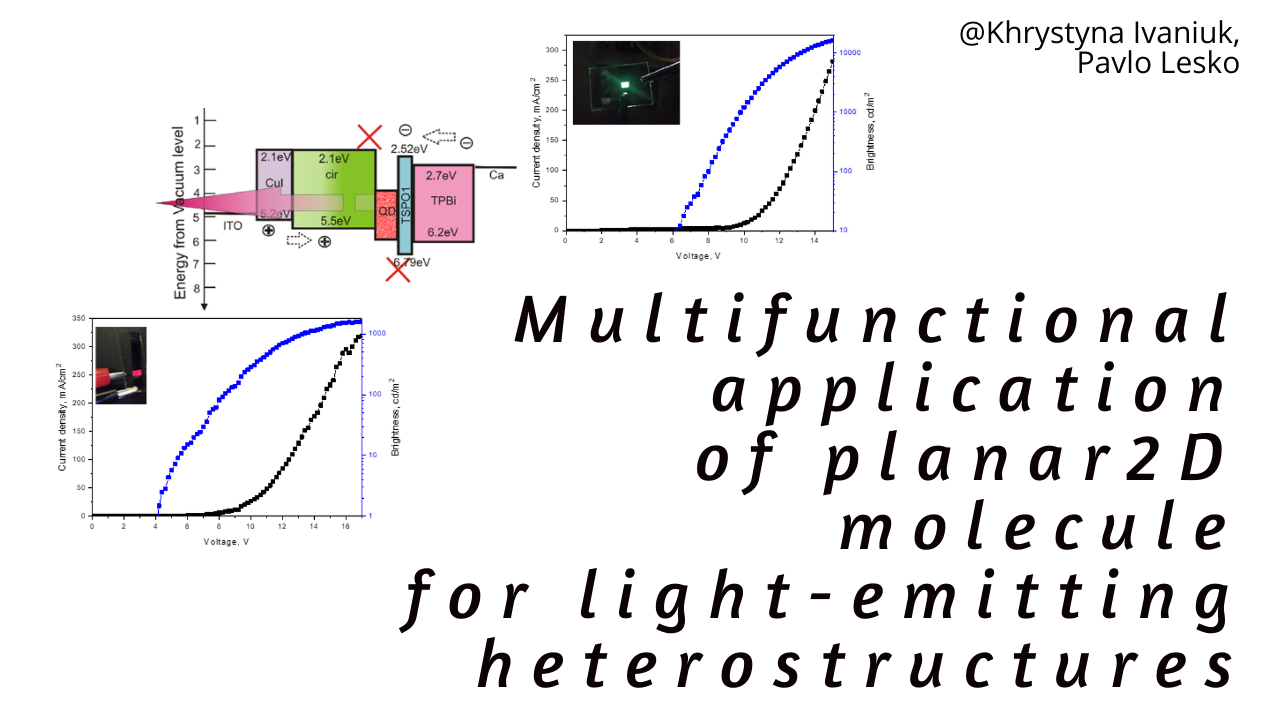Multifunctional application of planar 2D molecule for light-emitting heterostructures
DOI:
https://doi.org/10.15587/2706-5448.2024.306820Keywords:
organic light-emitting diodes, OLED, inverted OLED, quantum dots, electron-hole emissive recombinationAbstract
The object of research is the donor-acceptor compound, organic and hybrid heterostructures based on it. The paper is focused on a comprehensive approach to solving the problem of the efficiency of light-emitting devices, finding new technological and design solutions for the use of organic compounds as multifunctional materials for various types of light-emitting devices.
The paper presents the multifunctional application of a planar 2D molecule as an emission layer for typical and inverted types of light-emitting heterostructures, as well as a matrix for a host-guest system using inorganic quantum dots. The developed light-emitting structures are characterized by external quantum efficiency typical for fluorescent devices, but good stability over the entire length of the consumption voltage. QLED brightness is 1600 cd·m-2 and EQE 1.4 %, which are good parameters for use in display technology.
Organic LEDs based on planar molecules are promising candidates for use in modern lighting systems. A separate advantage of these light-emitting structures is the multifunctionality of using one compound for different types of light-emitting structures, including inverted heterostructures. Special attention is paid to the technological and design implementation of invert structures, since their geometry allows direct connection to the back board of the n-channel transistor on the substrate. In addition, organic LEDs have low energy consumption and are environmentally friendly due to the absence of toxic substances in their architecture, which creates the prerequisites for saving energy resources and reducing the industrial burden on the environment.
References
- Burdett, J. J., Müller, A. M., Gosztola, D., Bardeen, C. J. (2010). Excited state dynamics in solid and monomeric tetracene: The roles of superradiance and exciton fission. The Journal of Chemical Physics, 133 (14). doi: https://doi.org/10.1063/1.3495764
- Kryschi, C., Fleischhauer, H.-C., Wagner, B. (1992). The mechanism of singlet to triplet transitions of pentacene guests in p-terphenyl and benzoic acid crystals. Chemical Physics, 161 (3), 485–491. doi: https://doi.org/10.1016/0301-0104(92)80163-p
- Lee, Y., Kim, J., Jang, J. N., Yang, I. H., Kwon, S., Hong, M. et al. (2009). Development of inverted OLED with top ITO anode by plasma damage-free sputtering. Thin Solid Films, 517 (14), 4019–4022. doi: https://doi.org/10.1016/j.tsf.2009.01.185
- Chu, T.-Y., Chen, J.-F., Chen, S.-Y., Chen, C.-J., Chen, C. H. (2006). Highly efficient and stable inverted bottom-emission organic light emitting devices. Applied Physics Letters, 89 (5). doi: https://doi.org/10.1063/1.2268923
- Chen, D.-G., Lin, T.-C., Chen, C.-L., Chen, Y.-T., Chen, Y.-A., Lee, G.-H. et al. (2018). Optically Triggered Planarization of Boryl-Substituted Phenoxazine: Another Horizon of TADF Molecules and High-Performance OLEDs. ACS Applied Materials & Interfaces, 10 (15), 12886–12896. doi: https://doi.org/10.1021/acsami.8b00053
- Zhao, X.-D., Li, Y.-Q., Xiang, H.-Y., Zhang, Y.-B., Chen, J.-D., Xu, L.-H., Tang, J.-X. (2017). Efficient Color-Stable Inverted White Organic Light-Emitting Diodes with Outcoupling-Enhanced ZnO Layer. ACS Applied Materials & Interfaces, 9 (3), 2767–2775. doi: https://doi.org/10.1021/acsami.6b14778
- Mucur, S. P., Tumay, T. A., Birdoğan, S., San, S. E., Tekin, E. (2015). Triangular-shaped zinc oxide nanoparticles enhance the device performances of inverted OLEDs. Nano-Structures & Nano-Objects, 1, 7–14. doi: https://doi.org/10.1016/j.nanoso.2015.01.001
- Yeh, T.-H., Lee, C.-C., Shih, C.-J., Kumar, G., Biring, S., Liu, S.-W. (2018). Vacuum-deposited MoO3/Ag/WO3 multilayered electrode for highly efficient transparent and inverted organic light-emitting diodes. Organic Electronics, 59, 266–271. doi: https://doi.org/10.1016/j.orgel.2018.05.014
- Moon, H., Lee, C., Lee, W., Kim, J., Chae, H. (2019). Stability of Quantum Dots, Quantum Dot Films, and Quantum Dot Light-Emitting Diodes for Display Applications. Advanced Materials, 31, 1804294. doi: https://doi.org/10.1002/adma.201804294
- Ivaniuk, K. B., Baryshnikov, G. V., Stakhira, P. Y., Pedersen, S. K., Pittelkow, M., Lazauskas, A., Volyniuk, D. et al. (2017). New WOLEDs based on π-extended azatrioxa[8]circulenes. Journal of Materials Chemistry C, 5 (17), 4123–4128. doi: https://doi.org/10.1039/c7tc00655a

Downloads
Published
How to Cite
Issue
Section
License
Copyright (c) 2024 Khrystyna Ivaniuk, Pavlo Lesko

This work is licensed under a Creative Commons Attribution 4.0 International License.
The consolidation and conditions for the transfer of copyright (identification of authorship) is carried out in the License Agreement. In particular, the authors reserve the right to the authorship of their manuscript and transfer the first publication of this work to the journal under the terms of the Creative Commons CC BY license. At the same time, they have the right to conclude on their own additional agreements concerning the non-exclusive distribution of the work in the form in which it was published by this journal, but provided that the link to the first publication of the article in this journal is preserved.







